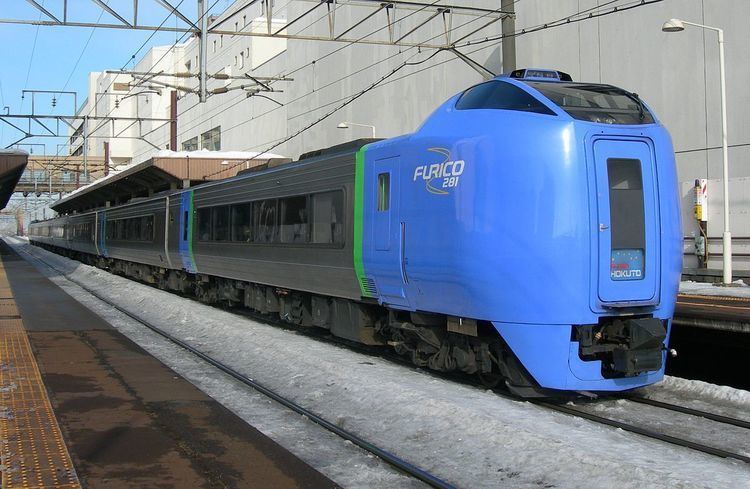In service 1994–Present Constructed 1992– Number in service 27 vehicles | Manufacturer Fuji Heavy Industries Number built 27 vehicles Formation 7-8 cars per trainset | |
 | ||
The KiHa 281 series (キハ281系) is a tilting diesel multiple unit (DMU) train type operated by Hokkaido Railway Company (JR Hokkaido) on Super Hokuto limited express services in Hokkaido, Japan since 1994. They were the first tilting trains to be operated by JR Hokkaido.
Contents
Formations
The fleet of 27 cars is normally formed into seven-car sets for use on Super Hokuto limited express services operating between Hakodate and Sapporo, and formations are sometimes lengthened to eight cars during busy periods.
7-car formations
7-car sets are normally formed as follows, with car 1 at the Sapporo end. Car 3 is a Green (first class) car.
8-car formations
Sets lengthened to 8 cars are normally formed as follows, with car 1 at the Sapporo end. Car 3 is a Green car.
KiHa 281-900
Pre-production driving (control) cars built by Fuji Heavy Industries and delivered in January 1992. Seating capacity is 48, with toilets.
KiHa 280-900
Pre-production intermediate car built by Fuji Heavy Industries and delivered in October 1992. Seating capacity is 60. The width of the side doors was increased from 800 mm on the KiHa 281-901–902 cars to 1,030 mm.
KiHa 281-0
Production driving (control) cars built by Fuji Heavy Industries and delivered from 1993. Seating capacity is 48, with toilets.
KiHa 280-0
Production intermediate cars built by Fuji Heavy Industries and delivered from 1993. Seating capacity is 51, with wheelchair space, universal access toilets, and a telephone.
KiHa 280-100
Production intermediate cars built by Fuji Heavy Industries and delivered from 1993. Seating capacity is 60, with conductor's compartment, but no toilets.
KiRo 280-0
Production Green (first class) cars built by Fuji Heavy Industries and delivered from 1993. Seating capacity is 26, with conductor's compartment, toilets, and a smoking area.
Interior
Passenger seating used the same rotating/reclining seats as used on the 785 series EMUs. Seating is arranged 2+2 abreast in standard class and 2+1 abreast in Green class.
Green car accommodation is scheduled to undergo a programme of refurbishment.
Pre-production sets
Two pre-production cars, KiHa 281-901 and KiHa 281-902, were delivered from Fuji Heavy Industries in January 1992 for evaluation and testing. A pre-production intermediate car, KiHa 280-901, also built by Fuji Heavy Industries, was delivered in October 1992 to form a 3-car set. The first two cars delivered used the same roller-tilting mechanism on the bogies as used on the earlier JR Shikoku 2000 series DMUs, whereas the third car delivered used a bearing-guide system. The pre-production 3-car train underwent test-running to evaluate the two different systems in the harsh winter conditions of Hokkaido. The later bearing-guide tilt mechanism proved superior, and this system was used on subsequent production trains delivered from 1993.
Entry into service
The KiHa 281 series entered revenue service from the start of the revised timetable on 1 March 1994. The new tilting trains operated at a maximum speed of 130 km/h (81 mph), reducing the journey time for the 318 km distance between Hakodate and Sapporo to 3 hours, shaving 30 minutes off the journey time for Hokuto services operated by KiHa 183 series DMUs.
The original "HEAT281" logo on cab sides of the pre-production trains was changed from "Hokkaido Experimental Advanced Train" to "Hokkaido Express Advanced Train" with the arrival of the production cars. This logo was later changed to "Furico 281" to match the style used on the newer KiHa 283 series trains.
Laurel Prize
The KiHa 281 series was awarded the Laurel Prize in 1995 for its outstanding functional and design features.
